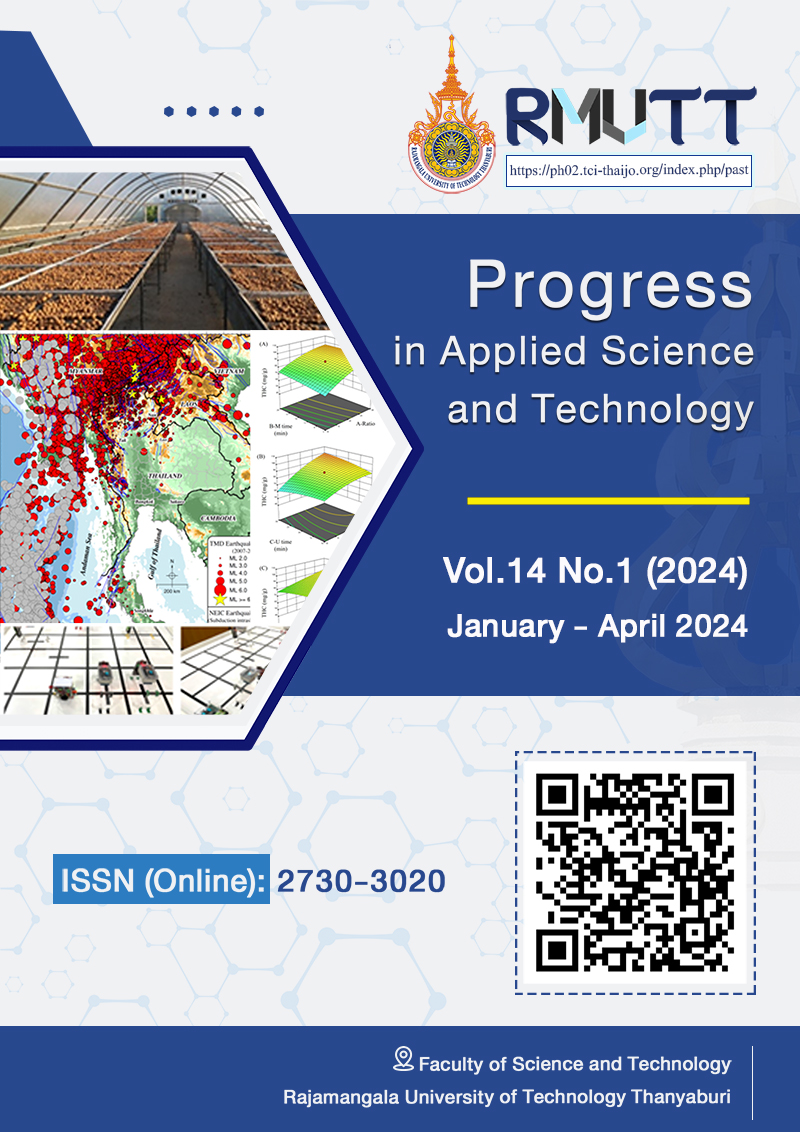Comparative Evaluation on Enhancing Fuel Properties of Biocoal from Bagasse Using Hydrothermal Carbonization and Torrefaction Processes
Main Article Content
Abstract
This research investigates the thermochemical conversion of sugarcane bagasse into biocoal using a subcritical aqueous medium (water, 200–250°C) and a limited oxygen atmosphere (nitrogen, 250–300°C). The aim is to discover alternative renewable energy sources to replace fossil fuels. The effects of those different methods on the physiochemical properties of the solid product were determined. The best results of fixed carbon (37.13%), carbon content (62.17%), fuel ratio (0.61), and higher heating value (HHV) (25.75 MJ/kg) were obtained under hydrothermal carbonization (HTC) at 250°C. Additionally, the HTC process effectively reduced the ash and sulphur content of the solid products. Moreover, HTC was found to be a promising method for depolymerizing hemicellulose. Hydrochar produced at 250°C is located within the range of lignite, which is typically obtained at lower reaction temperatures compared to biochar samples. Consequently, the conversion of sugarcane bagasse into solid biofuel through HTC shows great potential from a thermochemical perspective.
Article Details

This work is licensed under a Creative Commons Attribution-NonCommercial-NoDerivatives 4.0 International License.
References
Iwuozor KO, Chizitere Emenike E, Ighalo JO, Omoarukhe FO, Omuku PE, George Adeniyi A. A review on the thermochemical conversion of sugarcane bagasse into biochar. Clean Mater. 2022;6:100162.
Olugbade TO, Ojo OT. Biomass torrefaction for the production of high-grade solid biofuels: a review. BioEnergy Res. 2020;13(4):999–1015.
Sarker TR, Nanda S, Dalai AK, Meda V. A review of torrefaction technology for upgrading lignocellulosic biomass to solid biofuels. BioEnergy Res. 2021;14(2):645–69.
Sharma R, Jasrotia K, Singh N, Ghosh P, srivastava S, Sharma NR, et al. A comprehensive review on hydrothermal carbonization of biomass and its applications. Chem. Afr. 2020;3(1):1–19.
Cahyanti MN, Doddapaneni TRKC, Kikas T. Biomass torrefaction: an overview on process parameters, economic and environmental aspects and recent advancements. Bioresour. Technol. 2020;301:122737.
Lynam JG, Coronella CJ, Yan W, Reza MT, Vasquez VR. Acetic acid and lithium chloride effects on hydrothermal carbonization of lignocellulosic biomass. Bioresour. Technol. 2011;102(10):6192–9.
Zhang C, Chen WH, Saravanakumar A, Lin KYA, Zhang Y. Comparison of torrefaction and hydrothermal carbonization of high-moisture microalgal feedstock. Renew. Energy. 2024;225:120265.
Kambo HS, Dutta A. Comparative evaluation of torrefaction and hydrothermal carbonization of lignocellulosic biomass for the production of solid biofuel. Energy Convers. Manag. 2015;105:746–55.
Dang CH, Cappai G, Chung JW, Jeong C, Kulli B, Marchelli F, et al. Research needs and pathways to advance hydrothermal carbonization technology. Agronomy. 2024;14(2):247.
Babinszki B, Jakab E, Sebestyén Z, Blazsó M, Berényi B, Kumar J, et al. Comparison of hydrothermal carbonization and torrefaction of azolla biomass: analysis of the solid products. J. Anal. Appl. Pyrolysis. 2020;149:104844.
Chen WH, Ye SC, Sheen HK. Hydrothermal carbonization of sugarcane bagasse via wet torrefaction in association with microwave heating. Bioresour. Technol. 2012;118:195–203.
Mamvura TA, Pahla G, Muzenda E. Torrefaction of waste biomass for application in energy production in South Africa. South Afr. J. Chem. Eng. 2018;25:1–12.
Chen WH, Lu KM, Tsai CM. An experimental analysis on property and structure variations of agricultural wastes undergoing torrefaction. Appl. Energy. 2012;100:318–25.
Friedl A, Padouvas E, Rotter H, Varmuza K. Prediction of heating values of biomass fuel from elemental composition. Anal. Chim. Acta. 2005;544(1):191–8.
Kongto P, Palamanit A, Chaiprapat S, Tippayawong N, Khempila J, Lam SS, et al. Physicochemical changes and energy properties of torrefied rubberwood biomass produced by different scale moving bed reactors. Renew. Energy. 2023;219:119542.
Behnood R, Anvaripour B, Jaafarzadeh N, Farasati M. Oil spill sorption using raw and acetylated sugarcane bagasse. J. Cent. South Univ. 2016;23(7):1618–25.
Shankar Tumuluru J, Sokhansanj S, Hess JR, Wright CT, Boardman RD. A review on biomass torrefaction process and product properties for energy applications. Ind. Biotechnol. 2011;7(5):384–401.
Yang H, Yan R, Chen H, Lee DH, Zheng C. Characteristics of hemicellulose, cellulose and lignin pyrolysis. Fuel. 2007;86(12):1781–8.
Wolf M, Berger F, Hanstein S, Weidenkaff A, Endreß HU, Oestreich AM, et al. Hot-water hemicellulose extraction from fruit processing residues. ACS Omega. 2022;7(16):13436–47.
Wang Y, Yan B, Wang Y, Zhang J, Chen X, Bastiaans RJM. A comparison of combustion properties in biomass–coal blends using characteristic and kinetic analyses. Int. J. Environ. Res. Public. Health. 2021;18(24):12980.
Baxter L. Biomass-coal co-combustion: opportunity for affordable renewable energy. Fuel. 2005;84(10):1295–302.
Arauzo PJ, Atienza-Martínez M, Ábrego J, Olszewski MP, Cao Z, Kruse A. combustion characteristics of hydrochar and pyrochar derived from digested sewage sludge. Energies. 2020;13(16):4164.
de Paula Protásio T, Fernando Trugilho P, da Silva César AA, Napoli A, Alves de Melo ICN, Gomes da Silva M. Babassu nut residues: potential for bioenergy use in the North and Northeast of Brazil. SpringerPlus. 2014;3(1):124.
Mamvura TA, Danha G. Biomass torrefaction as an emerging technology to aid in energy production. Heliyon. 2020;6(3):e03531.
Chen WH, Du SW, Tsai CH, Wang ZY. Torrefied biomasses in a drop tube furnace to evaluate their utility in blast furnaces. Bioresour. Technol. 2012;111:433–8.
Li Y, Li L, Liu Y, Ren X, Chen J, Levendis YA. Sulfur and nitrogen release from co-pyrolysis of coal and biomass under oxidative and non-oxidative conditions. J. Energy Resour. Technol. 2020;5(46):30001-30010.
Lin Y, Ma X, Peng X, Hu S, Yu Z, Fang S. Effect of hydrothermal carbonization temperature on combustion behavior of hydrochar fuel from paper sludge. Appl. Therm. Eng. 2015;91:574–82.
Wu N, Niu Q, Pieters J, Ronsse F. Influence of torrefaction as pretreatment on the fast pyrolysis of sugarcane trash. Energy Convers. Manag. 2023;291:117291.
Devaraja UMA, Senadheera SS, Gunarathne DS. Torrefaction severity and performance of rubberwood and Gliricidia. Renew. Energy. 2022;195:1341–53.
Mueanmas C, Rakmak N. Enhancing the fuel properties of oil palm mesocarp fiber using screw conveyor reactor torrefaction. Energy Convers. Manag. 2023;298:117772.
Tumuluru JS. Comparison of chemical composition and energy property of torrefied switchgrass and corn stover. Front. Energy Res. 2015;3(46).
Yang W, Wu S, Wang H, Ma P, Shimanouchi T, Kimura Y, Zhou J. Effect of wet and dry torrefaction process on fuel properties of solid fuels derived from bamboo and Japanese cedar. BioResources. 2017;12(4):8629–40.






